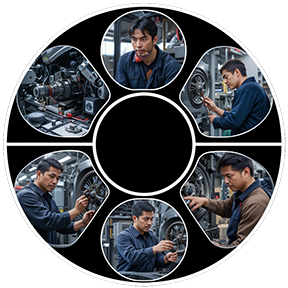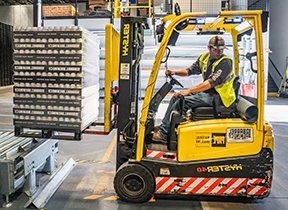Published: January 26, 2023 | Updated: October 07, 2025
Published: January 26, 2023 | Updated: October 07, 2025
Unlocking Operational Output: The CMMS Impact
 This discussion focuses unlocking operational output from a Computerized Maintenance Management System, or CMMS. Understanding how this system works requires defining key terms to ensure clarity. The following exploration delves into the various facets where a CMMS provides significant benefits to maintenance operations.
This discussion focuses unlocking operational output from a Computerized Maintenance Management System, or CMMS. Understanding how this system works requires defining key terms to ensure clarity. The following exploration delves into the various facets where a CMMS provides significant benefits to maintenance operations.
Defining Key Terms: CMMS, Monitoring, and Productivity
A Computerized Maintenance Management System (CMMS) stands as specialized software designed to assist and organize a maintenance department's operations. This system centrally manages assets, inventory, and work orders. Businesses of all sizes adopt such systems, as supervisors and technicians generally find them more approachable and user-friendly than traditional spreadsheets. Lists of assets, inventory, preventive maintenance schedules, and repair histories reside in one location, organized and readily accessible with a few clicks.
Effective CMMS utilization involves a commitment to data input and comprehensive training to ensure the system addresses the company's specific needs. While a CMMS also supports other functions, such as purchasing and barcoding, this discussion primarily focuses on its contribution to maintenance operations.
Understanding "monitoring" operational output necessitates a precise definition. Various interpretations of "monitor" exist, but for this context, a pertinent definition involves observing, recording, or detecting an operation or condition. While the CMMS itself acts as the instrument, its application directly influences the operation. A closer definition involves overseeing, supervising, or regulating, which aligns with a supervisor’s responsibilities as they utilize a CMMS to manage the department. The most fitting definition, however, suggests watching closely for purposes of control or surveillance, essentially keeping continuous track. This captures the essence of how a supervisor employs a CMMS.
The term "productivity" also requires careful consideration. One definition describes the quality, state, or fact of generating, creating, enhancing, or bringing forth goods and services. However, this definition presents a challenge due to its inherent subjectivity. Consider a scenario where one technician creates a single widget per hour, while another, equally skilled, produces ten widgets per hour. While the latter technician appears more productive, other factors demand examination. The technician producing ten widgets might compromise quality, leading to increased errors and a need for corrections, which ultimately reduces overall output. Safety concerns might also be disregarded in the rush to produce more. Conversely, if the first technician possesses the capability to produce five high-quality widgets per hour but only creates one, the output falls below potential. A CMMS helps to both monitor and measure output, providing supervisors with figures and statistics over time to assess performance and identify areas for improvement.
CMMS Applications for Enhanced Output
Numerous areas within a CMMS directly affect operational output. The communication methods a supervisor employs with the maintenance team significantly impact their output. Effective communication flows in both directions, laying a foundation for improved performance.
Asset Management’s Role in Output
Within asset management, clear communication proves important time after time. A supervisor needs comprehensive information about both equipment and non-equipment assets to formulate effective maintenance strategies.
While a detailed exploration of asset management could fill an entire discussion, one vital aspect of communication originates directly from the equipment itself, reported by line workers or documented by maintenance personnel through readings. These readings—temperatures, PSI, fluid levels, depth measurements, hours of operation, miles driven, etc.—inform proper preventive maintenance schedules. This precise data prevents over-servicing equipment, which otherwise reduces overall output.
Inventory Management and Its Effect on Output
 Inventory management within a CMMS also critically influences output. Several key areas stand out. The quantity of items in stock presents an obvious consideration. Maintenance operations require readily available parts. Running low on essential items or experiencing stockouts negatively affects output, especially during emergencies. A CMMS excels at tracking inventory quantities, preventing such disruptions.
Inventory management within a CMMS also critically influences output. Several key areas stand out. The quantity of items in stock presents an obvious consideration. Maintenance operations require readily available parts. Running low on essential items or experiencing stockouts negatively affects output, especially during emergencies. A CMMS excels at tracking inventory quantities, preventing such disruptions.
The location of inventory within a stockroom and established issue/return procedures represent additional factors. Knowing where inventory resides minimizes "search time" for workers, allowing them to dedicate more effort to actual maintenance tasks. A clearly defined issue/return policy, configured through a CMMS, also saves search time. A stockroom manager efficiently issues parts and accepts returned inventory. Authorization protocols on both ends promote better output by ensuring workers receive and return the correct items.
Discover how streamlined maintenance processes can elevate production. Learn more.
Work Order Management and Its Influence on Output
Work order management encompasses several factors that directly influence output. The type of job, its location, and its priority all play a role. Including detailed job steps or a checklist within a work order provides clear guidance. Knowing and including a bill of materials with the work order ensures technicians have the necessary parts. Assigning the job to the appropriate individual, crew, or craft also affects efficiency. Proper scheduling avoids overloading workers, a critical consideration for maintaining high output. Finally, comments appended to completed work orders provide valuable information for future work order management, contributing to sustained output levels.
After-the-Fact Work Orders
A beneficial feature of a CMMS involves the submission of "after-the-fact" work orders. When a technician finishes an assigned task and then observes another issue needing attention, they can address it and subsequently submit a work order for the completed, unscheduled work. This demonstrates initiative and contributes to increased output.
On-Time Compliance and Performance Analysis
A CMMS provides valuable insights into on-time compliance. If a job receives an estimated completion time of twenty minutes, but a technician takes sixty, the CMMS generates a report highlighting this discrepancy. A supervisor investigates the reason for the delay, revealing factors such as inventory problems, unclear work instructions, a need for more skilled technicians, the job requiring additional personnel, or unavoidable delays like a flat tire. These insights contribute to improving the execution of that job in the future. Conversely, if the same job finishes in ten minutes, the supervisor investigates the reasons for this efficiency. Was the initial estimate too high? Did the technician overlook a step or take shortcuts? Understanding these variations aids in refining future job estimates and procedures.
Attainment and Workload Management
Attainment metrics also provide crucial information. For instance, if an employee’s eight-hour shift includes only three hours dedicated to actual maintenance work, the department and supervisor receive a low percentage of productive time. As with delays, investigating the reasons behind this discrepancy is essential. While the CMMS generates the report, the supervisor needs to understand the circumstances behind the percentages. A goal of fifty percent or higher for productive time often stands as a target, but supervisors must ensure workers avoid excessive burdens. Overly demanding workloads can reduce overall output.
Morale and Its Indirect Impact on Output
While a CMMS does not directly monitor or measure employee attitude, it indirectly influences morale. By organizing and simplifying operations, a CMMS contributes to a more positive work environment for maintenance technicians. This increased positivity often results in higher operational output.
A CMMS serves as a powerful tool for monitoring and providing data on operational output. The supervisor utilizing the system plays a crucial role in ensuring the accuracy of inputted information to achieve beneficial outcomes. This requires a clear understanding of the data to provide the system and a commitment to maintaining a quality system from the outset.
FAQs
What is a CMMS and how does it improve maintenance operations?
A CMMS is software that centralizes asset, inventory, and work order management to streamline maintenance tasks and boost efficiency.
How does inventory tracking in a CMMS affect operational output?
By preventing stockouts and reducing search time, CMMS inventory tracking ensures technicians have the right parts when needed.
Can a CMMS help supervisors monitor technician productivity?
Yes, a CMMS provides performance metrics and compliance reports that help supervisors assess and improve technician output.
What role does work order management play in maintenance efficiency?
Detailed work orders with job steps, materials, and scheduling improve clarity and reduce delays in maintenance execution.
Does MAPCON CMMS support after-the-fact work orders?
Yes, MAPCON allows technicians to submit work orders for completed unscheduled tasks, enhancing responsiveness and output.
How does a CMMS indirectly improve employee morale?
By simplifying workflows and reducing confusion, a CMMS fosters a more organized environment that boosts technician morale.
MAPCON | 800-922-4336
MAPCON CMMS software empowers you to plan and execute PM tasks flawlessly, thanks to its wealth of features and customizable options. Want to see it for yourself? Click the button below to get your FREE 30-day trial of MAPCON!
Try It FREE!